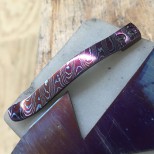How I Do It
| Blade Creation Process | ||
|
First, the blade is either ground to shape, or forged and then ground to the final shape. If the blade was forged, then the next step after grinding is to triple normalize to relieve any stress that occurred to the blade during forging.
Once the grinding is complete, the blade is hand-rubbed with sandpaper to either 220 or 400 grit. This provides a good smooth surface prior to heat-treat that will make it a little easier for final surface finishing. |
||
| Heat Treatment | ||
|
Now that the blade is completed, it's time for heat-treatment. I heat-treat all my blades in a temperature-controlled electric kiln (Paragon). This allows me to get the best performance out of the blade, depending on the type of steel used.
After the blade has reached the appropriate temperature and any soak time has been achieved, then the blade is quenched in either an oil, brine, or air, depending on the type of steel.
I currently use 1084, 1095, O1, W1, W2, 154 CM, CPM S35VN, CPM 3V, CPM S90V, AEB-L, N690, CPM 20CV, and different damascus steels. They each have unique temperature and quenching requirements to be able to get the best performance from the steel.
Some of the highly-alloyed steels are immersed in liquid nitrogen immediately after cooling to complete the blade steel conversion.
After the heating and quenching, the blade must be tempered. Depending on the steel used, the blade may be heated anywhere from 375F to 550F for 1, 2, or 3 one or two-hour sessions. |
||
| Finishing | ||
| The blades are hand-rubbed with sandpaper, progressing through the different coarseness grits until the desired finish is reached. For a "hard-use" type knife, I may only bring the final finish to around 220 grit, or for a "showier" knife, I may sand the blade all the way up to 1500 grit, which makes for a super smooth, satin finish. | ||
| Handles | ||
|
I use many different types of handle materials, ranging from no handle material at all, cord-wrapped, synthetic, and of course, different woods. I prefer to use stabilized woods whenever possible.
I no longer use Desert Ironwood, or anything in that family of woods, as they cause allergic reactions for me. |

